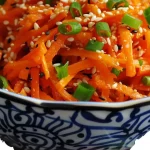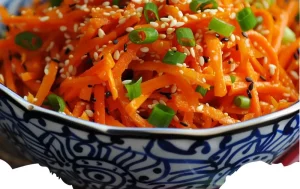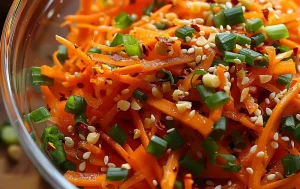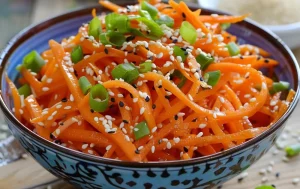Korean Carrot Salad, known as “Koryo-saram,” is a popular dish in Korean and Central Asian cuisine. This vibrant salad is made from julienned carrots that are seasoned with a spicy and flavorful dressing. Unlike traditional Korean dishes that use a variety of ingredients, this salad focuses on enhancing the natural sweetness and crunch of carrots with a mix of garlic, vinegar, and spices. It’s often served as a side dish and is renowned for its unique, piquant flavor profile that complements a variety of meals.
Print
Korean Carrot Salad
- Author: recipstep
- Total Time: 15 minutes
- Yield: Serves 4
- Diet: Vegan
Description
Korean Carrot Salad is a vibrant and spicy salad that combines julienned carrots with a flavorful dressing of vinegar, garlic, and spices. This dish is a staple in Korean and Central Asian cuisine, known for its piquant flavor that complements a variety of main courses.
Ingredients
4 large carrots, peeled and julienned
2 cloves garlic, minced
1 tablespoon fresh ginger, grated
2 tablespoons soy sauce
2 tablespoons sesame oil
1 tablespoon rice vinegar
1 tablespoon sugar
1 teaspoon crushed red pepper flakes (adjust to taste)
1 tablespoon sesame seeds
2 green onions, thinly sliced
Instructions
In a large bowl, combine the julienned carrots, garlic, and ginger.
In a small bowl, whisk together soy sauce, sesame oil, rice vinegar, sugar, and red pepper flakes until the sugar is dissolved.
Pour the dressing over the carrot mixture and toss well to coat.
Let the salad marinate in the refrigerator for at least 30 minutes to allow the flavors to meld.
Before serving, sprinkle with sesame seeds and green onions.
Notes
- For the best flavor, let the salad marinate overnight.
- Adjust the amount of red pepper flakes based on your preference for spiciness.
- Julienned carrots can be prepared using a mandoline slicer for uniformity and ease.
- Prep Time: 15 minutes
- Cook Time: 0 minutes (marinating time not included)
- Category: Salad
- Method: Mixing
- Cuisine: Korean, Central Asian
Nutrition
- Calories: 120
- Sugar: 7g
- Sodium: 150mg
- Fat: 7g
- Saturated Fat: 1g
- Carbohydrates: 13g
- Fiber: 3g
- Protein: 1g
- Cholesterol: 0mg
Frequently Asked Questions (FAQs)
How long can I store Korean Carrot Salad in the refrigerator?
Korean Carrot Salad can be stored in an airtight container in the refrigerator for up to 3-4 days. The flavors will continue to meld and intensify over time, but for the best texture, it’s recommended to consume it within the first couple of days.
Can I use pre-shredded carrots for this salad?
Yes, you can use pre-shredded carrots for convenience, but freshly julienned carrots are preferred for their fresher taste and crispier texture. Pre-shredded carrots tend to be drier and may not absorb the dressing as well.
Is Korean Carrot Salad spicy?
The spiciness of Korean Carrot Salad can vary depending on the amount of red chili flakes or fresh chilies used. You can adjust the level of heat to suit your taste preferences by increasing or decreasing the spices accordingly.
What makes Korean Carrot Salad different from other carrot salads?
Korean Carrot Salad is unique due to its dressing, which typically includes a combination of vinegar, garlic, coriander, sugar, and hot pepper. This gives it a distinctive spicy and tangy flavor that sets it apart from other carrot salads that might lean towards sweeter or more neutral flavor profiles.
Can I add other vegetables to this salad?
Absolutely! Korean Carrot Salad is versatile and can be enhanced with other vegetables like cucumbers, radishes, or bell peppers. Adding these can provide additional textures and flavors that complement the base of spicy seasoned carrots.
Key Ingredients and Flavor Profile
The success of Korean Carrot Salad lies in its simple yet robust ingredients. The primary ingredient, carrots, are julienned into fine strips to maximize surface area for the dressing to coat. The dressing typically includes garlic, coriander, hot red pepper, sugar, vinegar, and sometimes sesame oil. These ingredients combine to create a tangy, slightly sweet, and spicy flavor that makes this salad distinctive. For added complexity, some recipes might include onions or green onions, enhancing the overall taste and texture.
Preparation Techniques
Preparing Korean Carrot Salad involves several key steps to ensure the flavors meld properly. First, the carrots are peeled and julienned into thin strips. The dressing is then prepared by mixing vinegar, oil, spices, and other seasonings. It’s crucial to let the carrots marinate in this mixture for at least a few hours, or overnight if possible, to soften the carrots slightly and allow them to absorb the flavors fully. The longer the carrots marinate, the more pronounced the flavors become.
Serving Suggestions
Korean Carrot Salad is incredibly versatile and can be served in various ways. It’s commonly enjoyed as a side dish with rice and meat, particularly during gatherings and celebrations. However, it also works well as part of a cold appetizer spread or as an accompaniment to grilled meats and poultry, where its spicy and acidic notes provide a refreshing balance to richer flavors. Additionally, it can be added to wraps and sandwiches for an extra kick of flavor and crunch.
Variations and Customizations
While the basic recipe for Korean Carrot Salad is quite straightforward, it allows for various adaptations and customizations based on personal preference. Adding ingredients like crushed nuts, sesame seeds, or raisins can introduce new textures and flavors to the salad. For those who prefer a less spicy version, reducing the amount of hot pepper or substituting it with sweet paprika can adjust the heat level without sacrificing the overall flavor integrity. These variations make the salad adaptable to different tastes and occasions, ensuring it remains a favorite in any culinary setting.
Nutritional Benefits
Korean Carrot Salad is not only flavorful but also offers various nutritional benefits. Carrots are a great source of beta-carotene, which the body converts into vitamin A, essential for good vision, skin health, and immune function. The inclusion of garlic enhances the salad’s antioxidant properties, which can help combat oxidative stress. Additionally, the use of vinegar in the dressing promotes better digestion and can help regulate blood sugar levels. This makes the salad not only a tasty addition to meals but also a healthful one.
Dietary Adaptations for Special Needs
For individuals with specific dietary restrictions, Korean Carrot Salad can be easily adapted. For a lower sugar version, the amount of sugar can be reduced or substituted with a natural sweetener like honey or agave. Those on a sodium-restricted diet can limit or omit added salt, relying on the natural flavors of the garlic and spices to season the salad. Using a high-quality, unrefined oil such as extra virgin olive oil can also enhance the nutritional profile, adding healthy fats to the dish.
Enhancing Flavor Through Marination
The marination process is crucial in developing the deep, vibrant flavors of Korean Carrot Salad. Allowing the carrots to marinate for an extended period not only softens them to the perfect texture but also intensifies the infusion of the spicy and aromatic dressing. For best results, marinate the carrots for at least 12 hours. This slow marination allows the flavors to meld beautifully, creating a more cohesive and robust taste experience in every bite.
Tips for Perfect Julienned Carrots
Achieving perfectly julienned carrots is key to the texture and presentation of Korean Carrot Salad. For consistent results, use a mandoline slicer or a julienne peeler, which will help you create uniform strips quickly and safely. Ensure the carrots are fresh and firm; limp carrots will not hold up well in the salad. Cutting them uniformly ensures that each piece marinates evenly and provides a satisfying crunch.
Creative Uses in Meals
Korean Carrot Salad can be more than just a side dish; it has the versatility to be incorporated into various meals. It can add a flavorful crunch to a fresh spring roll or serve as a vibrant topping for a savory Asian-inspired taco. Mixing this salad into a grain bowl with quinoa, fresh greens, and a protein such as grilled chicken can transform it into a nutritious and filling meal. Its bright and tangy flavor also makes it an excellent addition to a buffet or potluck, where it can complement a wide range of dishes.
Seasonal Ingredient Variations
Integrating seasonal ingredients into Korean Carrot Salad can elevate the dish and adapt it to different times of the year. In the spring, adding radishes provides a peppery bite, while in summer, fresh herbs like cilantro or basil can add a light, aromatic touch. For autumn, mixing in some thinly sliced apples can introduce a sweet crispness that contrasts nicely with the spicy dressing. During winter, incorporating daikon radish or even shredded Brussels sprouts can offer a hearty texture that suits the colder weather, making the salad versatile and enjoyable year-round.
Allergy-Friendly Modifications
To accommodate individuals with food allergies, Korean Carrot Salad can be modified without compromising its distinctive flavor. For those allergic to sesame, omitting sesame oil and seeds is easy while still maintaining the salad’s character by increasing the other spices slightly. If nuts are a concern, ensure that any added garnishes like crushed peanuts are left out or replaced with seeds, such as pumpkin or sunflower seeds, which can provide a similar crunch without the allergen risk.
Utilizing Leftovers
Korean Carrot Salad is not only a fresh preparation but also an excellent way to utilize leftover vegetables. Adding leftover shredded cabbage or even sliced bell peppers can bulk up the salad, making it more substantial. This not only helps in reducing food waste but also enhances the nutritional value and texture of the dish. Using leftovers in this way can help transform the salad into a new and exciting meal each time it is served.
Hosting with Korean Carrot Salad
When hosting, Korean Carrot Salad serves as an excellent dish that adds color and flavor to the dining table. Its vibrant appearance and zesty taste make it a great conversation starter at parties or family gatherings. Serving this salad in a large, decorative bowl with garnishes like green onions and sesame seeds on top can make it stand out as a centerpiece. Additionally, its ability to be prepared in advance makes it very convenient for hosts, allowing them to focus on other aspects of meal preparation.
Pairing with Beverages
Pairing Korean Carrot Salad with the right beverages can enhance the dining experience. The spicy and tangy flavors of the salad pair well with light and crisp drinks. A chilled glass of Riesling or a sparkling white wine complements the heat from the salad nicely. For non-alcoholic options, iced green tea or cucumber water can provide a refreshing balance to the dish’s spice, making the meal more enjoyable and balanced.
Conclusion
Korean Carrot Salad is a vibrant, flavorful dish that serves as a wonderful addition to any meal. Its combination of crisp carrots, spicy dressing, and aromatic spices offers a delightful sensory experience that can awaken any palate. Whether served as a side dish, used as a topping for grilled meats, or enjoyed on its own, this salad is sure to impress with its unique taste and colorful presentation. Its flexibility in preparation and ingredient choice makes it a fantastic option for those looking to introduce variety into their diet while still enjoying delicious and healthy food options.





